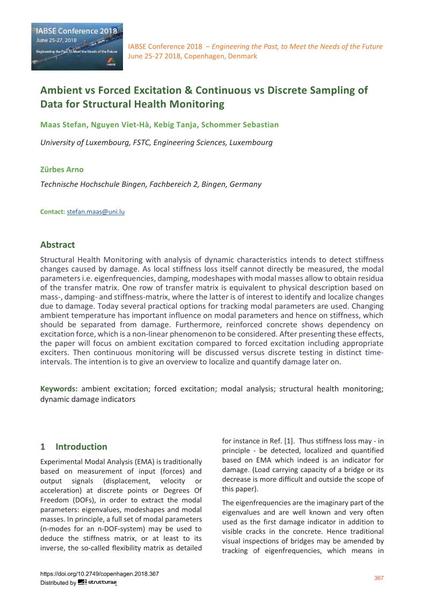Ambient vs Forced Excitation & Continuous vs Discrete Sampling of Data for Structural Health Monitoring

|
|
|||||||||||
Bibliografische Angaben
| Autor(en): |
Maas Stefan
(University of Luxembourg, FSTC, Engineering Sciences, Luxembourg)
Nguyen Viet-Hà (University of Luxembourg, FSTC, Engineering Sciences, Luxembourg) Kebig Tanja (University of Luxembourg, FSTC, Engineering Sciences, Luxembourg) Schommer Sebastian (University of Luxembourg, FSTC, Engineering Sciences, Luxembourg) Zürbes Arno (Technische Hochschule Bingen, Fachbereich 2, Bingen, Germany) |
||||
|---|---|---|---|---|---|
| Medium: | Tagungsbeitrag | ||||
| Sprache(n): | Englisch | ||||
| Tagung: | IABSE Conference: Engineering the Past, to Meet the Needs of the Future, Copenhagen, Denmark, 25-27 June 2018 | ||||
| Veröffentlicht in: | IABSE Conference Copenhagen 2018 | ||||
|
|||||
| Seite(n): | 367-375 | ||||
| Anzahl der Seiten (im PDF): | 9 | ||||
| DOI: | 10.2749/copenhagen.2018.367 | ||||
| Abstrakt: | Structural Health Monitoring with analysis of dynamic characteristics intends to detect stiffness changes caused by damage. As local stiffness loss itself cannot directly be measured, the modal parameters i.e. eigenfrequencies, damping, modeshapes with modal masses allow to obtain residua of the transfer matrix. One row of transfer matrix is equivalent to physical description based on mass-, damping- and stiffness-matrix, where the latter is of interest to identify and localize changes due to damage. Today several practical options for tracking modal parameters are used. Changing ambient temperature has important influence on modal parameters and hence on stiffness, which should be separated from damage. Furthermore, reinforced concrete shows dependency on excitation force, which is a non-linear phenomenon to be considered. After presenting these effects, the paper will focus on ambient excitation compared to forced excitation including appropriate exciters. Then continuous monitoring will be discussed versus discrete testing in distinct timeintervals. The intention is to give an overview to localize and quantify damage later on. | ||||
| Stichwörter: |
Modalanalyse
|
||||
